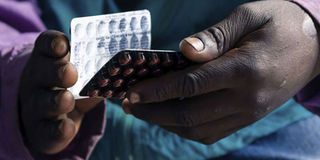TB infections, deaths likely to rise with focus on Covid-19

An HIV positive TB patient holds a packet of tablets received as part of his treatment at Rutsanana Polyclinic in Glen Norah township, Harare, Zimbabwe, on June 24, 2019. PHOTO | JEKESAI NJIKIZANA | AFP
What you need to know:
- With lockdowns and limitations on diagnosis, treatment, and prevention services, the study says, the annual number of global TB cases and deaths is expected to increase over the next five years.
- The World Health Organisation (WHO) had warned that, with all focus directed at containing Covid-19, more people are likely to die from the indirect effects of the pandemic.
- Already, about 411 people in Kenya contract TB while 90 die every day from the disease caused by bacteria that are spread through the air from person to person.
The number of people infected and dying of tuberculosis (TB) is likely to increase due to disruption of services, as countries focus more on containing the Covid-19 pandemic, a new study has shown.
With lockdowns and limitations on diagnosis, treatment and prevention services, the study says, the annual number of global TB cases and deaths is expected to increase over the next five years, to levels last seen between 2013 and 2016.
This means that globally, efforts made to control TB will suffer a five to eight-year setback before they are efficiently resorted, resulting in 6.3 million cases and an additional 1.4 million deaths 2020 and 2025.
These estimates were done based on a three-month lockdown and a protracted 10-month restoration of services, the team of experts said.
“Lockdowns are potentially affecting systems put in place to combat TB. There is a lost opportunity and even after the lockdown is lifted, the pick up will be slow,” said Dr Nimalan Arinaminpathy, an associate professor of mathematical epidemiology at the MRC Centre for Global Infectious Disease Analysis, Imperial College London.
INDIRECT EFFECTS
The World Health Organisation (WHO) had warned that, with all focus directed at containing Covid-19, more people are likely to die from the indirect effects of the pandemic.
For instance, the Ministry of Health in Kenya in April directed counties to suspend all minor and elective surgeries in preparation for Covid-19 emergencies.
Kenya is one of the three countries where the study launched by Stop TB Partnership was done.
Now, the first modelling analysis shows that each month taken to return to normal TB services would incur an additional 1,157 deaths between 2020 and 2025 in Kenya.
The modelling show an additional 40,685 deaths in India and 137 in Ukraine over this period.
“Today, governments face a torturous path, navigating between the imminent disaster of Covid-19 and the long-running plague of TB," said Dr Lucica Ditiu, Executive Director of the Stop TB Partnership.
"But choosing to ignore TB again would erase at least half a decade of hard-earned progress against the world’s most deadly infection and make millions more people sick."
KENYA NUMBERS
Already, about 411 people in Kenya contract TB while 90 die every day from the disease caused by bacteria that are spread through the air from person to person.
The TB cases in Kenya are mainly driven by the burden of HIV cases. If not treated properly, the serious disease that mainly affects the lungs can be fatal.
Further, people infected with TB bacteria (known as Mycobacterium tuberculosis) who are not sick can take medication to prevent the disease from developing in the future.
“As such, the global TB incidences and deaths in 2021 would increase to levels last seen in between 2013 and 2016 respectively,” the study notes.
Building on work by the 2019 Lancet Commission on TB, the modelling focuses on three high burden settings: India, Kenya and Ukraine.
Estimates from these countries were also extrapolated to create global estimates for the impact of Covid-19 on TB.
The modelling did not capture the consequences of the correlation between TB and Covid-19.
IMMUNISATION
When health systems are overwhelmed, the WHO notes, both direct mortality from an outbreak and indirect mortality from vaccine-preventable and treatable conditions increase “dramatically”.
One of the things likely to be affected is immunisation.
“We never learn from mistakes. For the past five years, TB, a respiratory disease, has remained the biggest infectious disease killer because the ‘TB agenda’ consistently became less visible in front of other priorities,” said Dr Ditiu.
The new study was commissioned by the Stop TB Partnership in collaboration with the Imperial College, Avenir Health and Johns Hopkins University, and was supported by USAID.
In 2018, during the UN General Assembly (UNGA) High-Level Meeting on TB, Heads of States and governments committed to significantly scale up the TB response.
In 2018, this resulted in identifying an additional 600,000 people who could access TB care.
INFECTION RATE
While research is ongoing on the 100-year-old Bacille Calmette-Guérin (BCG) vaccine, to see if it can be repurposed and used to protect people against Covid-19, the team of scientists say little effort has been placed to address the disease.
This is the case yet people with active TB can infect five to15 others through close contact over the course of a year.
“We only have three vaccine candidates and are in need of up to $600 million to develop a vaccine, while we are seeing up to 100 vaccine candidates being developed for Covid-19,” said Dr Ditiu.
Supplementary measures include ramping-up active case-finding alongside intensive community engagement and contact tracing to maintain awareness on the importance of recognising and responding to symptoms suggestive of TB, using digital technology and other tools.
“Securing access to an uninterrupted supply of quality-assured treatment and care for every single person with TB will be essential,” said Dr Arinaminpathy.


